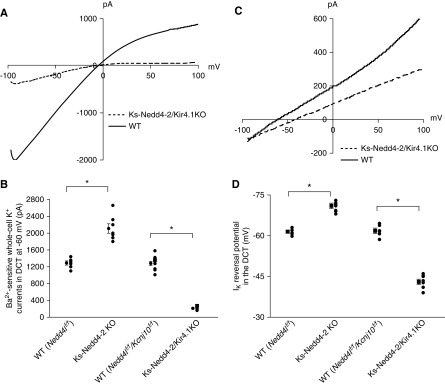Figure 4.
Double deletion of Nedd4-2 and Kir4.1 depolarizes DCT membrane. (A) Representative whole-cell recordings showing the Ba2+-sensitive K+ currents measured with ramp protocol from −100 to 100 mV in the DCT1 of WT mice (Kcnj10flox/flox/Nedd4lflox/flox) and Ks-Nedd4-2/Kir4.1 KO mice (dotted line). (B) A scatter graph summarizes the values measured at–60 mV with whole-cell recording. The mean value and SEM are shown on the left of each row. For the whole-cell recording, a symmetric 140 mM K+ solution was used for the bath and the pipette. (C) A perforated whole-cell recording showing the K+ current (IK) reversal potential in the DCT of WT and Ks-Nedd4-2/Kir4.1 KO mice. (D) A scatter graph summarizes the results of experiments in which the IK reversal potentials were measured in WT and Ks-Nedd4-2/Kir4.1 KO mice. The mean value and SEM are shown on the left of each row. For the measurement of IK reversal potential, the bath solution contains 140 mM NaCl and 5 mM KCl, whereas the pipette solution has 140 mM KCl. Data for WT (Nedd4lf/f) and Ks-Nedd4-2 KO mice in (B) and (D) are duplicated from Figure 2, B and D, respectively, for the comparison. *Significant difference (P=0.05) determined by t test.

